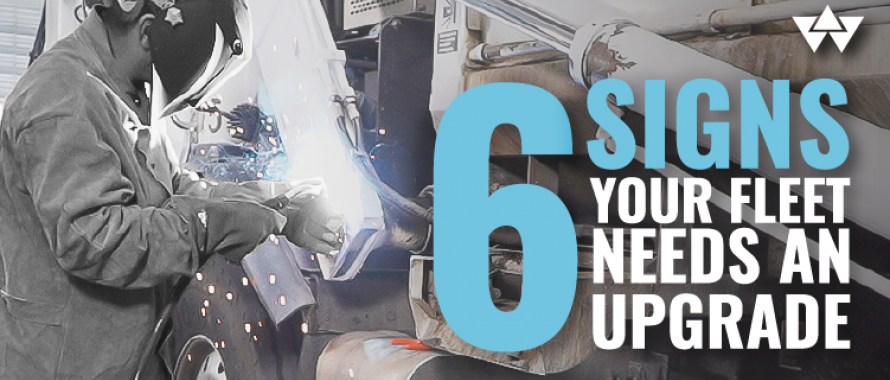For businesses and municipalities that engage heavily in waste handling and transport, the successful completion of the day-to-day workload hinges largely on a properly functioning vehicle fleet. And when vehicles go out of commission, jobs are often left undone — and the customer complaints begin rolling in.
6 signs that a fleet update may be due
Obviously, this all makes proper vehicle maintenance and repair a top priority for these businesses and municipalities. But sometimes, vehicles in the fleet are simply outdated, and a vehicle update can usher in significant efficiency improvements and substantial reductions in downtime.
Consider these six indications that a vehicle (or multiple vehicles) in your fleet may be in need of replacement:
-
Persistent breakdowns — When a vehicle’s downtime becomes a frequent problem — and your service department or out-of-house mechanic is seeing the vehicle over and over again — this may be the most apparent sign that a replacement might be worth considering. While the equipment upgrade will obviously carry a considerable price tag, the savings in repair costs and the reduction in vehicle downtime can bring rewards that make the investment worthwhile.
-
Trailing technology — Newer vehicles often deliver technological advancements that make a fleet easier, safer and more efficient to operate. (Just a few of the advances in this area that may make the investment more attractive include backup cameras, GPS navigation systems and hands-free mobile phone technology, all of which can support added safety and route efficiency.) Further, newer vehicles can often support more advanced diagnostics and monitoring systems, which can deliver alerts that spur needed maintenance in a timely manner — and help fleet managers avoid potential added repair costs.
-
Surging fuel consumption — When it comes to the profitability of those in waste handling and transport, fuel costs tend to be a leading factor. And newer vehicles typically deliver (sometimes greatly) increased fuel efficiency, which can result in especially impactful cost savings when gas and diesel costs are climbing. If your fleet is seeing added fuel costs, and a decrease in profits as a result, a vehicle upgrade may be well worth considering — and the savings in fuel costs can help defray the costs of the investment.
-
Discontented drivers — Of course, a vehicle fleet can’t get much done without its drivers — and ignoring driver concerns can result in both staffing problems and mounting vehicle-performance issues. If you begin to notice an uptick in driver apprehension about driving a particular vehicle in the fleet, whether the concern revolves around the vehicle’s safety or its performance, it’s critical to look into the concerns being expressed. And when repair and/or maintenance fail to address the concerns, a vehicle upgrade may be in order.
-
Mounting mileage — Typically, vehicles in a waste handling and transport fleet face fairly grueling/formidable tasks on a daily basis, making their lifetime mileage expectancy a good bit lower than that of a general transport vehicle. So when a fleet vehicle’s mileage starts getting into the ballpark of 100,000 or higher — or even lower, depending on the conditions a vehicle is typically working in — it may be time to start looking into replacement. And high mileage paired with increasingly regular shop time is a clear sign that it’s time for a vehicle upgrade.
-
Excessive age — Even if a fleet vehicle’s mileage hasn’t reached the usual level of concern noted above, vehicles that exceed five years in age are still good candidates for replacement. This is because, at this age, most vehicles have outlasted their warranty periods, making repairs substantially more expensive for the fleet’s owner — and often making replacement a more financially attractive option.
Ready to help with fleet updates, maintenance, and repair
To help ensure the longevity and proper functioning of your fleet’s vehicles, the Wastequip family of brands offers a number of trusted options for parts, services and maintenance. A couple of the most noteworthy highlights among them include:
-
Wastebuilt serves as an all-in-one parts supplier for businesses and municipalities in the waste industry, providing refuse body parts, chassis parts and container parts for a range of the most common brands used in the industry, along with hoses, fittings and MRO & safety supplies.
-
Wastequip WRX offers a number of readily available service centers spread throughout the nation that can provide needed maintenance, repair and equipment installation for both new and old fleet vehicles and hoists, along with OEM or aftermarket parts and tarping systems. In some locations, mobile technicians can even perform services and repairs on-site at customers’ facilities, greatly reducing the hassle of having needed work performed. And Wastequip WRX’s arm repair program for ASLs and frontloaders can help keep older equipment functional for longer and downtime to a minimum via repair and refurbishment of all makes and models of automated side loader (ASL) and frontloader arms.
About Wastequip
Wastequip is the leading North American manufacturer of waste handling equipment, with an international network of manufacturing facilities and the most extensive dealer network in the industry. Wastequip’s broad range of waste and recycling equipment, trucks and systems is used to collect, process and transport recyclables, solid waste, liquid waste and organics. The company’s brands include Amrep®, Accurate™, ConFab®, ContainerPros®, Galbreath®, Mountain Tarp®, Pioneer™, Toter®, Wastebuilt®, Wastequip®, Wastequip WRX™ and wasteware™. For more information, visit www.wastequip.com.
